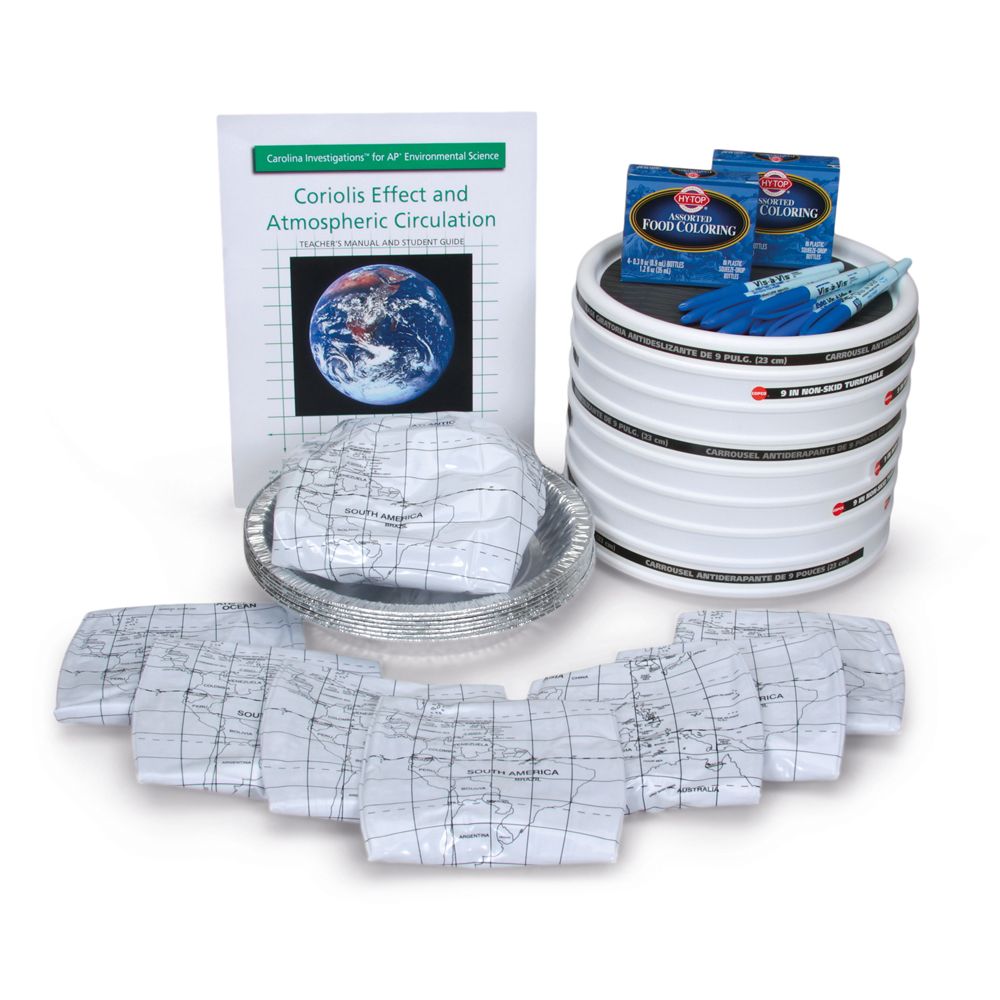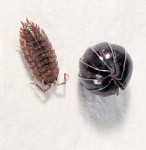The Ups and Downs of Weather
A Carolina EssentialsTM Demonstration

Total Time: 10-30 mins
Prep: 10-30 mins

Earth and Space Science
6-12
Middle/High School
Overview
Three concepts are paramount to understanding weather basics: temperature, pressure, and the Coriolis effect. Air temperature and pressure affect the density of an air mass. Differences in density set up convection currents that move air both vertically and horizontally within the atmosphere. Convection currents lead to pressure gradients that drive air across the surface of the earth, and the Coriolis effect explains apparent deflections in direction. Meteorologists report parameters such as temperature, air pressure, wind speed, and wind direction. These concepts can be demonstrated quickly and visually for students in an introductory demonstration or small group activity at the beginning of a weather unit.
Essential Question
How do temperature, pressure, and the Coriolis effect drive weather?
Demonstration Objectives
- Explain the relationship between temperature, pressure, density, and convection currents.
- Build a model of weather using the variables of temperature, pressure, and the Coriolis effect.
Next Generation Science Standards* (NGSS)
SCIENCE & ENGINEERING PRACTICES
Constructing Explanations
- Students will be able to relate temperature and pressure to convection current development and then use the Coriolis effect to explain weather.
DISCIPLINARY CORE IDEA
ESS2: Earth’s Systems
- HS-ESS2-2 Analyze geoscience data to make the claim that one change to Earth's surface can create feedbacks that cause changes to other of Earth's systems.
- MS-ESS2-4 Develop a model to describe the cycling of water through Earth's systems driven by energy from the sun and the force of gravity.
- Students will be able to explain the processes in the atmosphere that lead to weather development.
CROSSCUTTING CONCEPTS
Cause and Effect
- Students will be able to explain how changes in temperature and pressure result in the development of convection currents, which, along with the Coriolis effect, move air masses vertically and horizontally across the earth's surface.
Materials
Part 1: Temperature
- Large resealable plastic bag
- Ice
- Match
- Hot Water
- 1000-mL beaker or large jar
Part 2: Pressure
- Soft-sided plastic water or soda bottle
- Tap Water
- Match
Part 3: Convection Currents
- 4 foam cups
- Food coloring, 4 colors
- Tape
- Water
- Ice
- Clear plastic tub or fish tank
- Sharp pencil or dissecting probe
Part 4: Coriolis Effect
- Graph paper or transparency grid paper
- Turntable
- Whiteboard markers, 2 colors
Safety and Disposal
Wear safety goggles.
- Part 1: Use gloves or a pot holder to handle the beaker of hot water. Be careful with lit matches.
- Part 2: Be careful with lit matches.
- Part 3: Use gloves or a pot holder to handle the cups of hot and warm water.
All water can be poured down a drain. Wipe off transparency grids with a damp cloth.
Procedures
- Part 1 and Part 3: Heat water before the demonstration. It can be microwaved.
Have ice available in a cooler. - Part 2: Have students save plastic water bottles from lunch or get them from the
recycling container. Remove the labels.
STUDENT PROCEDURES
Part 1: Temperature
- Fill a sealable bag with ice. Seal and set aside.
- Fill the large beaker or jar 1⁄4 to 1⁄3 full with hot water, about 40 to 50℃.
- Strike a match and drop it into the water.
- Quickly place the bag of ice on top of the beaker
- Observe for 3 to 5 minutes.
- Look for condensation/cloud above the hot water.
Lift the bag of ice off the beaker. Observe.
Part 2: Pressure
- Put just enough water in the empty water bottle to cover the bottom of the bottle.
- Cap the bottle and shake it vigorously.
- Uncap the bottle.
- Light a match and immediately put it in the water bottle. Cap the bottle.
- Squeeze and release the bottle repeatedly.
- Make observations.
Part 3: Convection Currents
- Fill the tank 3⁄4 full of tap water.
- Fill one foam cup with ice, a small amount of water, and 3 drops of blue food coloring.
- Tape the cup to one corner of the tank so the bottom of the cup is beneath the surface of the water.
- Fill the second cup with cold water and 3 drops of green food coloring.
- Tape the cup to one corner of the tank so the bottom of the cup is beneath the surface of the water.
- Fill the third cup with warm water and 3 drops of yellow food coloring.
- Tape the cup to one corner of the tank so the bottom of the cup is beneath the surface of the water.
- Fill the fourth cup with hot water and 3 drops of red food coloring.
- Tape the cup to one corner of the tank so the bottom of the cup is beneath the surface of the water.
- Quickly poke a small hole in the bottom of each foam cup.
- Make observations for at least 10 to 15 minutes and as many as 30 minutes.
Part 4: Coriolis Effect
- Draw a horizontal line across the grid paper and label it equator. Write an N above the line and an S below it.
- Tape the grid paper to the turntable securely, aligning the equator with the center of the turntable.
- Begin by rotating the turntable counterclockwise.
- While the table is rotating, draw a straight line on the northern (N) half of the paper from the center of the turntable to the end of the paper without lifting the pen.
- Repeat the procedure while rotating the turntable at a faster speed.
- Change pen colors. Now rotate the turntable clockwise.
- While the table is rotating, draw a straight line on the southern (S) half of the paperfrom the center of the turntable to the end of the paper without lifting the pen.
- Repeat the procedure while rotating the turntable at a faster speed.
TEACHER PREPARATION AND TIPS
- There must be smoke from the match in the beaker.
- Do NOT let the ice drip or sink into the beaker.
- Look for condensation/cloud above the hot water.
- Make sure students are focused on the beaker.
- The bottle must contain the smoke from the match.
- It may take several rounds of squeezing and releasing to get a cloud to form. Clouds are easier to see in a dark room.
- For this demonstration to work well, the water samples must be quantifiably different from each other and different from the tap water in the tank.
- You can experiment with the placement of the cups to visualize what happens with extreme temperature differences and similar temperatures.
- Discuss the direction of earth’s rotation and frame of reference. The earth appears to rotate counterclockwise from the North Pole but clockwise from the South Pole.
- To ensure a straight line is drawn, have a student hold a ruler horizontally slightly above the turntable.
Data and Observations
- Part 1:Temperature
Air is cooled and a cloud forms. - Part 2: Pressure
Air is compressed, decompressed, and a cloud is formed. Students may notice a change in temperature if completing the activity themselves. - Part 3: Convection Currents
Each temperature/color takes its own path. Cool and cold samples tend to sink; warm and hot samples stay near the surface and spread out. - Part 4: Coriolis Effect
When the turntable is turned counterclockwise, a straight line is deflected to the right. When the turntable is turned clockwise, a straight line is deflected to the left. The faster the turntable moves, the greater the deflection.
Analysis & Discussion
Part 1: Temperature
What phase changes were illustrated in the temperature demonstrations?
Evaporation and condensation
What weather phenomenon is illustrated by this demonstration?
Cloud formation, temperature decrease, increase in density, or convection current
Part 2: Pressure
What phase changes were illustrated in the pressure demonstrations?
Evaporation and condensation
What did squeezing the bottle do to the air inside the bottle?
It compressed the air, which increased the pressure, keeping the water liquid.
What did releasing the bottle do to the air inside the bottle?
It decompressed the air, which decreased the pressure, allowing the water to vaporize.
What weather phenomenon is illustrated by this demonstration?
Cloud formation, pressure changes, density changes, or convection current
Part 3: Convection Currents
How did each color of water move?
The colder temperatures sank, and the warmer ones stayed closer to the top.
Why do the colors tend to form layers?
The temperatures are different so the densities are different.
If the tank was left undisturbed for a long period, what would the color of the water be? Why?
The water would be brown to black because there would be complete mixing when thermal equilibrium was met.
What principle does the tank illustrate?
It illustrates density differences and convection currents.
Should the principle work the same in air (gas) as it does in water (liquid)?
Yes—both states of matter can transfer kinetic energy between particles.
Part 4: Coriolis Effect
In the northern hemisphere, which way was the straight line deflected?
To the right
In the southern hemisphere, which way was the straight line deflected?
To the left
SHOP THE KIT
SAFETY REQUIREMENTS
- Safety Gloves Required
- Safety Goggles Required
- Open Flame
HELPFUL LINKS
VIEW MORE ESSENTIALS
*Next Generation Science Standards® is a registered trademark of Achieve. Neither Achieve nor the lead states and partners that developed the Next Generation Science Standards were involved in the production of, and do not endorse, these products.
About The Author
Carolina Staff
Carolina is teamed with teachers and continually provides valuable resources–articles, activities, and how-to videos–to help teachers in their classroom.



